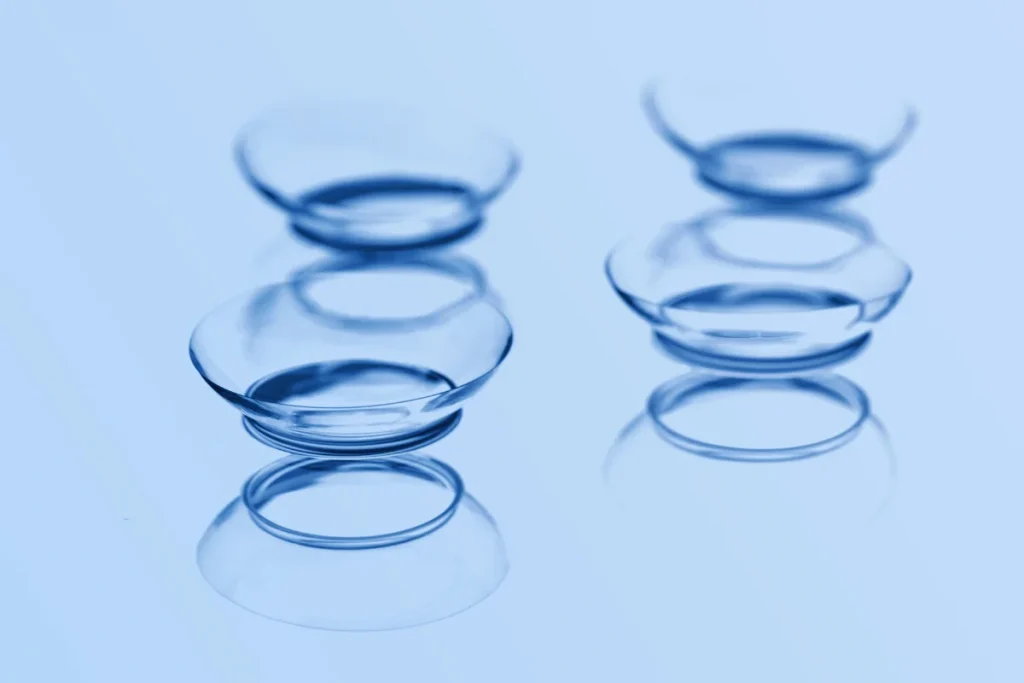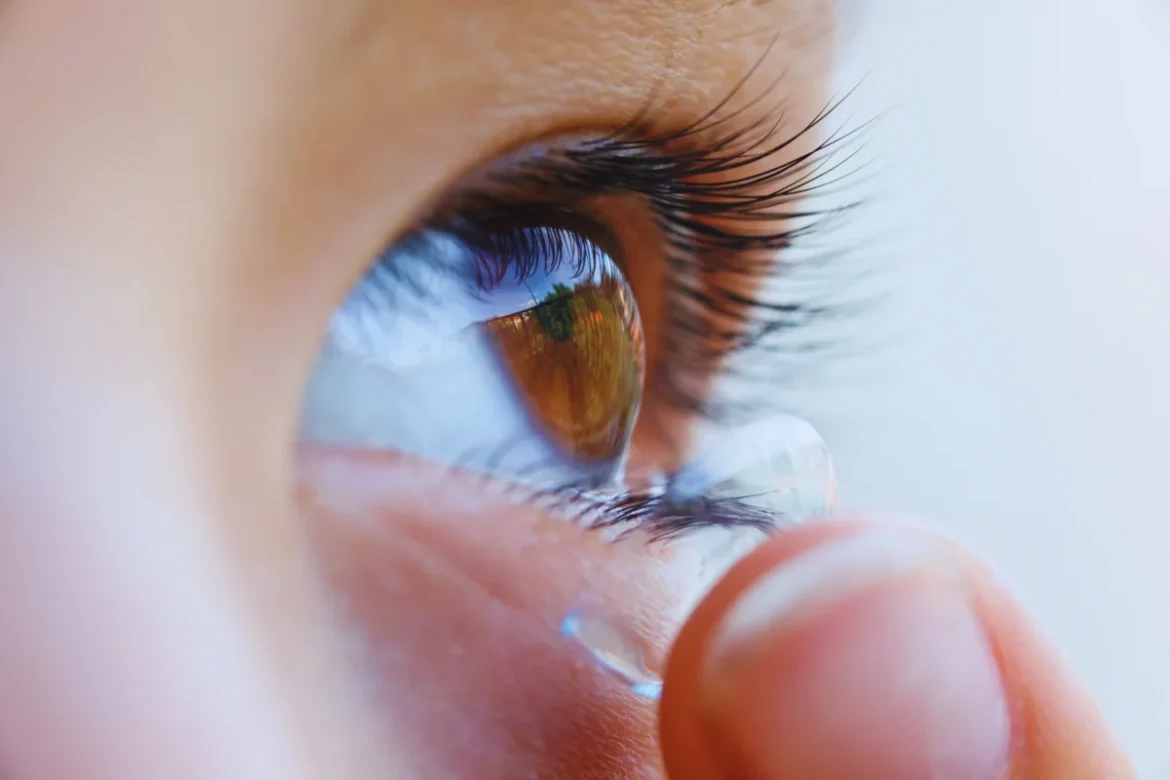Contact lenses are a popular and convenient choice for people who need vision correction. They offer more freedom than glasses and are great for active lifestyles.
But just like any medical device, they need to be used correctly. One common question people ask is: how long should you wear contact lenses in a day? Wearing them too long can lead to dry eyes, discomfort, or even more serious eye problems if not handled properly.
In this blog, we’ll help you understand the recommended contact lens wear time, what factors can affect how long you should keep them in, and the signs that you may be overwearing your lenses. You’ll also learn simple tips to keep your eyes safe, comfortable, and healthy throughout the day.
General Guidelines for Contact Lens Wear Time
For most people, the recommended time to wear contact lenses is between 8 to 12 hours per day. This range helps keep your eyes comfortable and allows enough oxygen to reach the cornea. Wearing contacts for too long can lead to dryness, irritation, and in some cases, more serious issues like eye infections.

Different types of lenses also come with different wear schedules.
1. Daily disposable lenses are designed for single-day use and should be thrown away after each wear.
2. Bi-weekly lenses are typically worn during the day and stored at night for up to two weeks before being replaced.
3. Monthly lenses can last up to 30 days but must be removed, cleaned, and stored properly each night.
There are also extended wear lenses, which are specially approved for overnight or continuous wear. However, not everyone is a good candidate for these lenses. Only wear them overnight if your eye care provider has given you specific approval.
It’s important to remember that there is no universal rule for everyone. The right wear time depends on your lens type, eye health, lifestyle, and how your eyes respond to lens use.
Always follow the instructions provided by your eye care professional, and if you notice discomfort before the recommended time is up, it’s best to remove your lenses and give your eyes a break.
Factors That Influence How Long You Can Wear Contacts
While general guidelines suggest wearing contact lenses for 8 to 12 hours a day, several factors can affect how long they remain safe and comfortable for your eyes.
One of the biggest influences is the type of lens you wear. Soft lenses are flexible and commonly used for daily comfort. Rigid gas permeable (RGP) lenses allow more oxygen through but may take longer to get used to.
Silicone hydrogel lenses offer better oxygen flow and can be worn for longer periods. Daily disposables are convenient and reduce the risk of infections but must be thrown away after one use.

Your eye health and sensitivity also play a key role. If you have dry eyes, allergies, or any existing eye condition, your eyes might not tolerate long wear times.
Tear film quality is another factor. A healthy tear film keeps lenses moist and comfortable. If your eyes don’t produce enough tears or the tears evaporate too quickly, you may need to shorten your wear time.
Environmental conditions such as air conditioning, dust, long hours in front of a screen, or exposure to pollutants can also dry out your eyes and reduce lens comfort.
Finally, your wearing habits matter. Poor hygiene, not cleaning or storing lenses properly, or wearing them longer than prescribed can increase your risk of discomfort and infection. Listening to your eyes and following proper care routines can help you enjoy longer, safer wear.
Risks of Wearing Contact Lenses Too Long
Wearing contact lenses longer than recommended can lead to several eye health issues, some of which may become serious if ignored.
One major risk is hypoxia, a condition where your cornea doesn’t get enough oxygen. Since contact lenses cover the eye’s surface, extended wear can reduce oxygen flow and cause swelling, blurred vision, and discomfort.
Another common problem is dry eyes. When you wear lenses for too long, your eyes may not stay properly lubricated. This can lead to irritation, burning, and a gritty feeling. It’s especially common in people who work long hours in front of screens or in air-conditioned environments.
Overuse can also lead to corneal abrasions, which are small scratches on the surface of the eye. These can be painful and increase your risk of developing a corneal ulcer, a more serious and potentially vision-threatening condition.
Perhaps the most concerning risk is an increased chance of infections, such as keratitis, which can be caused by bacteria, fungi, or parasites. Sleeping in lenses or poor hygiene can make this more likely.
You might also notice eye fatigue and redness, which are signs that your eyes are overworked and not getting the rest or oxygen they need.

To learn more about these issues, check out our related post: [Common Contact Lens Problems: Causes, Solutions & Prevention Tips].
Always listen to your eyes and remove your contacts at the first sign of discomfort.
Signs You’re Wearing Contacts for Too Long
Your eyes will usually give you clear signals when you’ve worn your contact lenses for too long. Ignoring these signs can lead to discomfort or more serious issues. If you notice any of the symptoms below, it’s best to remove your lenses and let your eyes rest.
Here are some common warning signs:
- Itchy, dry, or red eyes: These are early signs of eye fatigue or reduced oxygen flow.
- Blurred or foggy vision: This could mean your lenses have dried out or shifted on your eye.
- Burning or stinging sensation: Often caused by dryness or irritation from overwear.
- Feeling like there’s something in your eye: This may indicate a damaged lens or debris trapped under it.
- Sensitivity to light: Also known as photophobia, this can signal eye strain or even an infection.
If you experience any of these symptoms regularly, consider shortening your wear time or switching to a more breathable lens. And if the discomfort doesn’t go away after removing your contacts, consult your eye care provider for advice.
Best Practices for Safe and Comfortable Lens Wear
Wearing contact lenses can be safe and comfortable when you follow the right habits. To protect your eye health, start by following your optometrist’s recommendations closely. They’ll guide you on the correct lens type, wearing time, and care routine based on your individual needs.
Always wash and dry your hands before handling your lenses. This helps prevent bacteria from transferring to your eyes and reduces the risk of infection.
Use only approved contact lens cleaning solutions. Never rinse or store lenses in tap water, as it can contain harmful microorganisms that may cause serious infections.
Stick to your prescribed wearing schedule. Whether you wear daily, bi-weekly, or monthly lenses, don’t extend their use beyond the recommended time. Give your eyes time to rest each day, especially if you’ve worn lenses for several hours.
It’s also a good idea to switch to glasses occasionally. Giving your eyes a break helps restore moisture and oxygen levels.
Make sure to replace your lenses as directed, even if they still feel comfortable. Overused lenses can collect deposits and reduce oxygen flow.
Lastly, don’t skip regular eye exams. Your eye care professional can detect early signs of irritation, infection, or changes in vision and adjust your lens prescription if needed.
FAQs About Contact Lens Wear Time
Can I wear contact lenses all day?
You can typically wear contacts for 8 to 12 hours a day, but this depends on the type of lenses and your eye health. If your eyes feel tired or irritated before then, it’s best to remove them.
Is it okay to nap in contact lenses?
Unless your lenses are specifically approved for extended or overnight wear, you should avoid napping in them. Sleeping in regular contacts can increase your risk of infection and dryness.
Are daily contacts safer for longer wear?
Daily disposables are designed for short-term use and are generally safer because you use a fresh pair each day. However, they should still be removed after the recommended wear time—usually no more than 12 hours.
What’s the difference between day and night lenses?
Day lenses are made for daily wear and must be removed before sleep. Night or extended wear lenses are approved by eye care professionals for overnight use, but not everyone is a good candidate for them.


